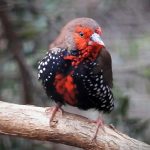PAINTED FINCH
Painted Finches are known for their vivid and attractive plumage. They have a bright red face and throat, a white belly, and black markings on their wings, back, and tail. The males have a striking black bib, while the females are slightly duller in color.
Painted Finches are primarily found in the northern and central parts of Australia. They are known to inhabit arid and semi-arid regions, often favoring open woodlands and grassy areas. They are often found in grassy woodlands, savannas, and open plains. They are known to forage on the ground, and their colorful plumage blends in well with the grass and shrubs of their habitat. Painted Finches have adaptations that help them thrive in arid environments. They are well-suited to the often challenging conditions of the Australian outback, where water and food resources can be scarce.
Painted Finches are primarily seed-eaters. They feed on a variety of grass seeds and other small seeds they can find on the ground. They also eat insects, particularly during the breeding season, to provide essential nutrients for their chicks.
Painted Finches construct their nests in tree hollows or in abandoned tree branches. They usually lay 3-5 eggs per clutch, and both the male and female take turns incubating the eggs and feeding the chicks. Breeding typically occurs after rainfall, which triggers an increase in food availability.
Painted finches are generally less vocal than other Australian grass-finches; however, its calls are among the loudest and harshest of this species group.
Painted Finches are known for their social behavior. They often form small flocks, especially during the non-breeding season. These flocks can consist of individuals from multiple family groups.
The Painted Finch is not currently listed as a threatened species, but its numbers are declining in some areas due to habitat loss and changes in fire regimes.
Painted Finches are known for their acrobatic displays, particularly during courtship. Males often perform elaborate flight displays to attract females.
These birds are not only visually striking but also offer insights into the unique ecosystems of Australia’s arid interior. It’s important to respect their habitat and the surrounding environment when seeking to view them in the wild, as they play a valuable role in their ecosystems.






